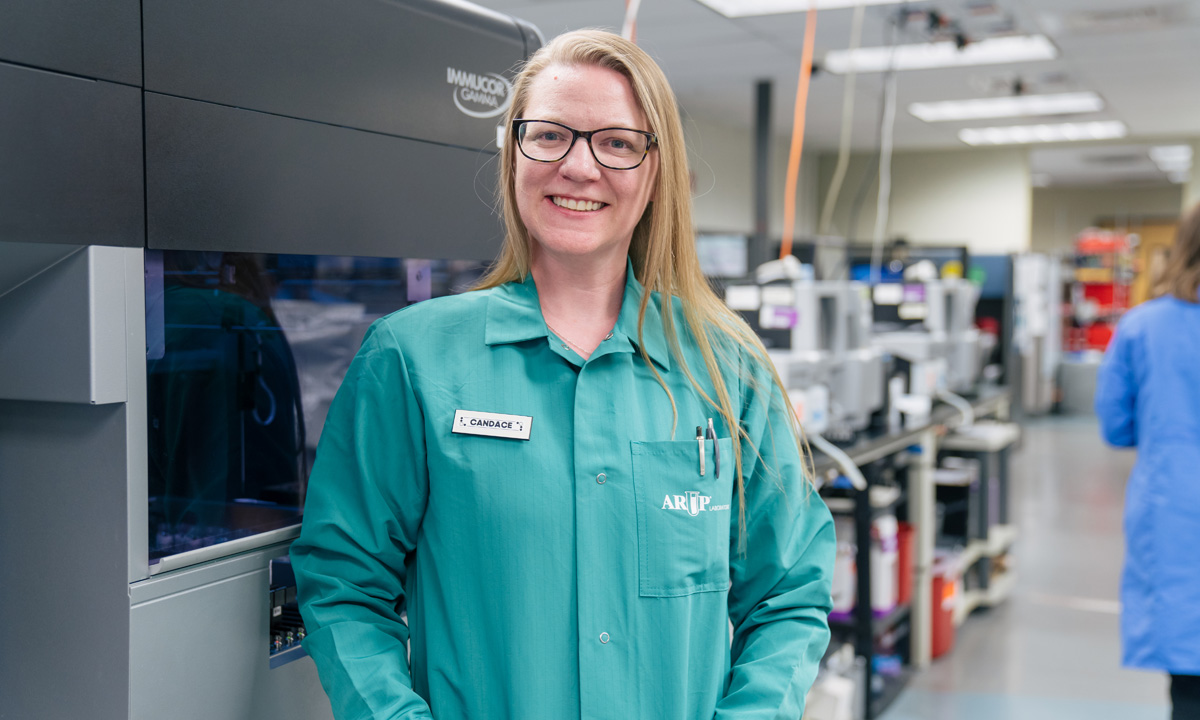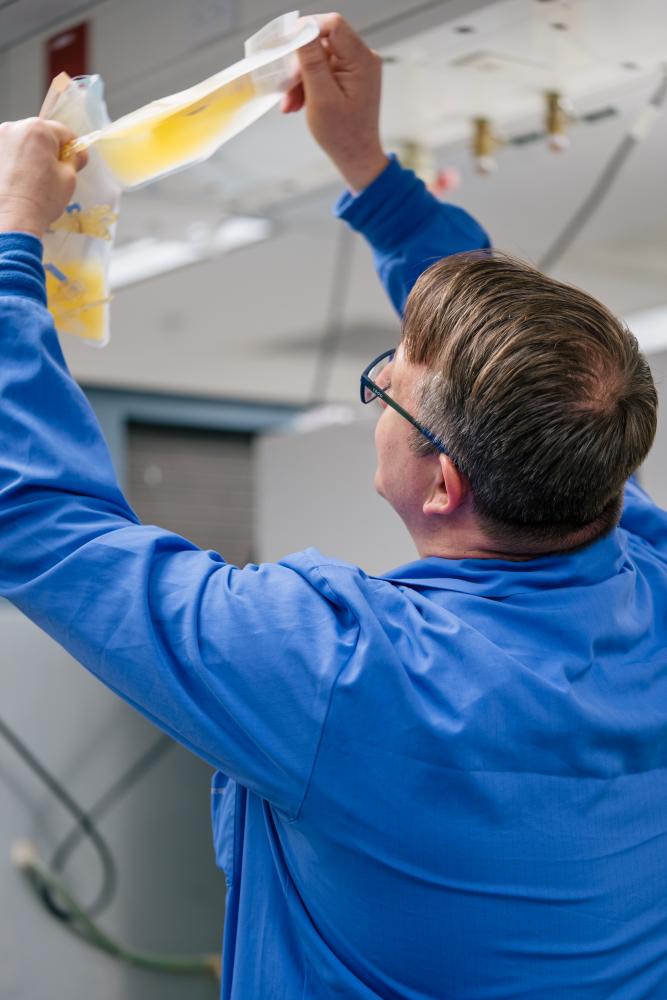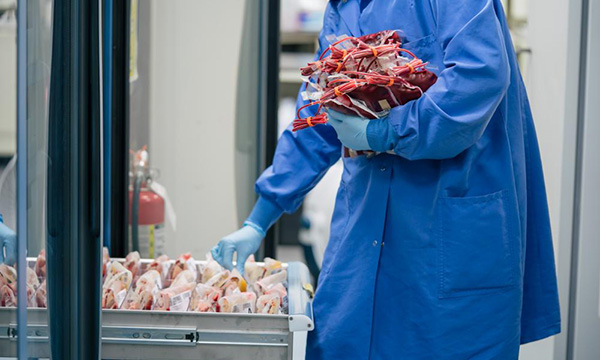
“There are critical care staff keeping patients alive as we speak, and we need to turn around blood products fast in order for patients to survive,” says Candace Thomas, BCS, workflow coordinator.
A patient on the transplant unit desperately needs the straw-colored fluid in the bag that Cassidy Rapier is holding up to the fluorescent light. He eyes the platelets as they swirl in plasma.
Rapier is a blood component specialist (BCS) and part of a tight-knit team of about 60 people who work in ARUP’s Transfusion Services Laboratory, located beyond a labyrinth of hallways deep within the University of Utah Hospital.
“There are critical care staff keeping patients alive as we speak, and we need to turn around blood products fast in order for patients to survive,” says Candace Thomas, BCS, workflow coordinator.
In the lab, refrigerators are restocked daily and hold eight different blood types of donor red blood cells. Two large freezers contain bags of plasma, which take approximately 30 minutes to thaw and need to be used within five days of thawing. The transfusion lab provides blood products for Huntsman Cancer Institute patients as well.
When a patient with traumatic injuries arrives in the emergency room or a cancer patient is receiving a blood transfusion, it is critical that they receive blood types compatible with their bodies. Receiving the wrong blood type or receiving blood with antigens that may trigger an immune response in the patient could be fatal.

““At the end of the day, I go home and think about that liver patient that needed four units of plasma, and I think, ‘Okay, I did my part to help someone live today,’” says blood component specialist Cassidy Rapier.
“Our blood component specialists are our first line of defense and our last,” says Thomas. When a request for a patient arrives, the BCS reviews the history of the patient. Have they been a patient here before? What is their blood type? Have any antibodies been detected previously? If there is a request for plasma, the BCS begins thawing and modifying it into a transfusable product.
Some patients with low immunity need to be transfused with red blood cells and platelets that have been irradiated in order to prevent transfusion-associated graft versus host disease. This is a rare complication where donor lymphocytes mount an immune response against recipient tissues.
Babies need very small volumes due to their size, so the blood is prepared in syringes. Other patients may need red blood cells that have been washed to remove the residual plasma that contains proteins, potassium, and other constituents. All these steps are performed by the BCS.
This responsibility brings a smile to Rapier’s face. “At the end of the day, I go home and think about that liver patient that needed four units of plasma, and I think, ‘Okay, I did my part to help someone live today.’”
Once the transfusion lab has determined the type of blood a patient needs, future blood requests for that patient can be processed within 30 minutes. For first-time, critical-care patients, it takes approximately 90 minutes to prepare and cross-match a donor’s blood with the patient’s blood type when no antibodies are present. Weekly, the lab provides blood products for nearly 800 transfusions.
“Some patients’ needs for transfusions are more predictable, for instance those with planned surgeries or who are cancer patients,” explains Ryan Metcalf, MD, medical director for ARUP Transfusion Services. He is also an assistant professor of pathology at the U of U School of Medicine. Metcalf works closely with U of U Health departments where transfusions are common. “It’s harder to predict the blood needs for trauma patients who may need a lot of blood suddenly. We always need to be prepared for these cases.”
Trauma cases spike in the summer when kids are out of school and people are recreating more. But this is also the time of year when fewer donors give blood.
Blood Detectives that Save Lives
“The intensity of getting patients the blood they need unifies us as a team. We have all become very close and really respect what each of us brings to the process,” says medical technologist Katy Bean. Once the BCS have done their part, Bean and her colleagues use a combination of an automation system and manual laboratory techniques to confirm the blood type and screen for the presence of antibodies. This is a crucial step to cross-match the patient’s plasma with the donor’s blood. “I’m always thinking about the patient behind the blood,” says Bean. “They’re not far from us.”
If one of Bean’s samples screens “positive” with automated analysis, that’s a red flag and she investigates further to figure out the cause. “They put on their investigative hats and start looking for antibodies,” says Thomas. “If we still can’t figure it out, we’ll send it to our sister lab, the ARUP Immunohematology Reference Lab (IRL).” IRL is an AABB-accredited reference lab. Hospitals from across the country send their difficult antibody identifications to them.

The final step for BCSs is carefully dispensing blood to nursing staff who arrive regularly to pick up blood or platelets, often for the emergency department or surgery units. Strict protocols are in place to ensure the right blood goes to the right patient, including a bar code check at the patient’s bedside to match the medical record number on their wristband with the barcode on each bag of blood.
“A complex, large hospital cannot run without a well-functioning blood bank,” says Metcalf. “It is not unusual for our labs to receive emails or letters of thanks from care teams. They realize what a vital part our laboratorians play in the health of their patients.”
Peta Owens-Liston, Sr. Science Communications Writer
Related blog
"The Dangers of Being Unique: What Makes Blood Rare?"
"When Your Own Blood Turns on You: A Journey of Endurance through Multiple Myeloma"
















